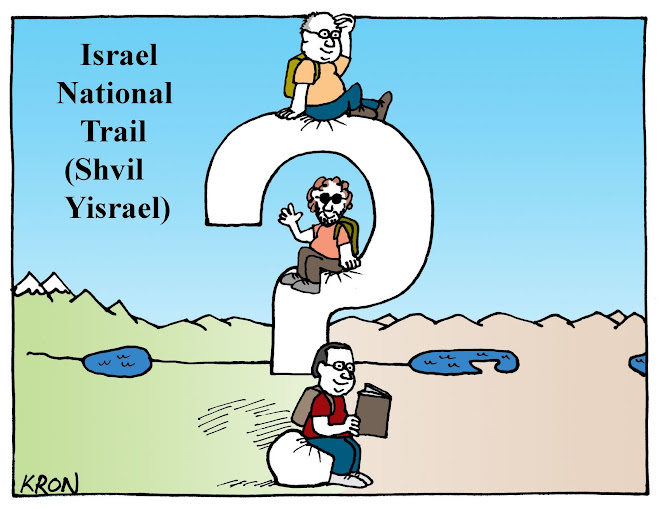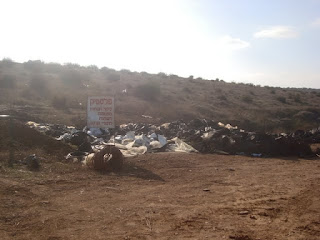
I awoke bright and early the next morning, refreshed after a good night's sleep. Yoni and Garry didn't get up nearly as energetically, ascertaining that my snoring kept them awake all night. They even went as far as claiming that the aural resonance was so deafening that the air-force scrambled fighter planes, thinking that our friends in Gazza were testing a new type of missile. Garry tried to record my snoring using the microphone on his cell-phone but upon play-back all I heard was the sweet sounds of contented sleep. As far as I'm concerned, I suspect a conspiracy…their claims are identical to those Susan has been complaining about these last twenty something years. In any case, I heard mumbled threats of locking me in a sound-proof cell next time we do an overnight.
Snoring or not, it's amazing what a good cup of coffee and a brie, avocado and prosciutto sandwich can do to shake off the cobwebs. After preparing rolls for the day's walk, by 7.30 we'd loaded the cars and bade farewell to the Galon guesthouse. Upon consultation with the book it was decided we would park at Moshav Achuzam and thus save ourselves a kilomtre's walk along the road. Yoni was especially happy with Achuzam, as it fitted very nicely into his Negev-retro theory. Here was a moshav that hasn't changed since the 60's. In fact, I think most of the houses hadn't been painted since the 60's. Many moshavim today have a new community neighbourhood built within the settlement. These community neighbourhoods offer relatively cheap land and building to people who want to live in a country environment but still desire all the advantages of middle-class living. Yoni and I both live in community settlements. Time-warped Achuzam doesn't seem to have heard of this very common trend. This old-style moshav looks a bit run-down, with chickens houses or small dairies adjacent to their unkempt properties. The roads are pot-holed and the cars either dilapidated bombs or modern, expensive, status-mobiles. Not many standard Hyundies here. It appeared as if modernity had skipped past this corner of the Negev.
Unfortunately the trail markings at Achuzam were no-where to be found. According to the second book, the shvil takes an entirely different route, some 3 km to the south. We've noticed minor discrepancies between the two books but never to this degree. Eventually we found shvil markings that had been painted over. The route had obviously changed and no-one bothered to inform the poor old bugger who wrote the first book. Once we realized that the updated route avoided road walking (a wise update, indeed) then we parked at Tel Keshet and drove to the starting point at Lachish, where we'd finished the day before. By 8.30, a little later than planned, we were on the track. With only 14 easy kilometres to do, the later-than-planned start was not critical.

It wasn't surprising that the first part of the walk was the same as the previous day's; vineyards. Occasionally we walked between the rows and found bunches of grapes still on the vine that hadn't been picked. Left on the vine they dry out slowly and become raisins. Intensely sweet, moist and natural we gobbled them straight off the vine and they were delicious.
Not far from the start we walked past what looked like an agricultural equipment dumping ground, full of used irrigation piping, large plastic sheets and some old abandonned tires. Next to it was a small sign in Hebrew and next to that a large sign in Thai. Obviously it's the Thai workers, who do nearly all the agricultural work in Israel today, that needed the instruction regarding the dump. I don't know if this mess was indeed a dump or a sort of recycling depot. Perhaps if they needed to lay pipes or use a large black plastic sheet they would take it from here rather than use costly new equipment. My Thai isn't good enough to understand the sign so I can't be certain what this place was meant to be used for.
We did spot, however, an interesting piece of recycling. In an area of small, newly planted vines, the tender trunks were protected by Tnuva 1-litre milk cartons. Quite a weird sight, walking past a young vineyard with row after row of milk cartons on the ground around thin tree-trunks. Maybe it’s a new hybrid, milk flavored grape variety, or a ready grown grape milkshake.
From memory (in my case an unreliable piece of equipment), we saw our first ultra-light in the almost two years of shvilling, buzzing overhead like an overgrown mosquito. The pilot did a couple of passes over us, once flying low enough to wave at us. Unfortunately the slow shutter response of my camera and slow neuron response of my brain, prevented me from successfully taking a photo, but you'll have to believe me on this one. Garry and I thought flying in an ultra-light over the region would be a great experience. Yoni, still traumatized by jumping out of a plane with just a parachute on his back during his army service, is only willing to leave the ground these days protected by at least 20 tons of metal and powered by a minimum of 2, preferably 4, jet engines.
Not for the first time on the shvil, we saw horses and riders gallop past. Usually we see them in small groups of 3 or 4. Today it was a full posse, at least twenty in number. There were no bad guys in this posse, however. Each rider politely waved us a cheery hello as he rode past on his trusty steed. Very civilised.
Gradually the scenery changed from vineyards to wheat fields. The wheat fields this time of year are very attractive, especially when they totally surround you. We've only had one serious bout of rain this season so the wheat has only just sprouted. The deep brown colored earth is still visible under the green of the wheat sprouts and with the soft winter light it's a very pleasant walking environment… especially if you're walking through gentle, undulating hills that cause barely a drop of sweat. If we did start to sweat, there's no shortage of trees sprinkled along the path to rest under. And if a single tree is not enough, then there are a few small eucalyptus groves of about twenty trees along the way. Very considerate.
Eventually the fields gave way to uninteresting bare terrain, but so far over these 2 days we'd walked 16 pleasant kilometres, so a bit of boredom is nothing to complain about. As if to further remind us that Shvil Yisrael is not all pretty rural scenery, Mr. shvil painter has us walk towards, beside and eventually under kvish 6. Just when we thought we'd seen the last of it, up it pops. And it's just as much an eye-sore in the Negev as in the centre of the country. (Unless I'm driving on it. Then it's a god-send.)
As we were about to cross under kvish 6 we walked passed a single concrete block in the middle of the path with the familiar shvil sign painted on it. The block had no obvious purpose other than to be there so Mr shvil painter could put a sign on it. How and why Mr shvil painter convinced the Shvil Elders to drop this concrete obelisk in the middle of no-where is a mystery to me. Of the series of books I am planning to publish when we finish the shvil, sometime around the turn of the next decade, this anomily will certainly appear in the volume titled "Mysteries of the Shvil", alongside "The Shvil on a Full Stomach" and "The Driver's Guide to the Shvil". Does anyone know a brave (foolhardy?) publisher?

We'd left the agriculture behind and were now walking above the banks of nachal (creek) Adura'im. It's a dry creek that only runs when it rains, where flash floods run through the creeks in the Negev and the water disappears as quickly as it appears. Thorny acacia trees dot the banks of the creek. We found ourselves one particularly large and shady one to rest under. We sat down on a bed of small drying orange acacia berries and finished off our lunch sandwiches. Ah…this is the life! Thirty minutes later we were back at Garry's car, having completed the easiest 14, or 22 km including the previous day, that you can imagine.
Getting back to Yoni's car entailed making quite a large loop along the no. 40 road and then kvish 6. Boring. We thought that if we drove along a few dirt tracks we'd find a short cut, make the drive more interesting and save about 15 minutes driving. We were driving in Garry's Mazda 3 which, with three grown adults inside, sits about 10 cm off the road. When the "road" is a track that resembles an obstacle course, with myriad obstructions 11 cm or higher, well, need I continue? At one point I got out of the car and cleared rocks from the path (I wouldn't even call it a track) so the car could pass. In the beginning the dirt track was quite reasonable but as we continued "reasonable" changed to poor which changed to terrible. And suddenly there was no track at all. Just a field, a shiny blue Mazda 3 and Yoni and I walking in front or behind, trying to help Garry navigate through. Seinfeld, anyone? Eventually we got to an unsealed road that seemed like an autobahn after what the car had been through. This road came to the main road that we'd wanted to get to in the first place. After 45 minutes of Leyland Brothers impersonation (the Australians will understand) we arrived to the point that allowed us to save 15 minutes.
That was the last of the adventures, unless stopping off for ice cream along the much shvil-maligned kvish 6 counts.
All in, I can safely say that we implemented the lessons from our first overnight trip; This time we had an easy first day, we prepared food and water for the next day, we weren't out till too late, we got a decent night's sleep (or at least I did) and we picked a really nice route that suited us. There's no doubt that the decision to jump forward was the right one. We'll do a few more Negev walks before going back to the area around Jerusalem. We're really looking forward to them.









































